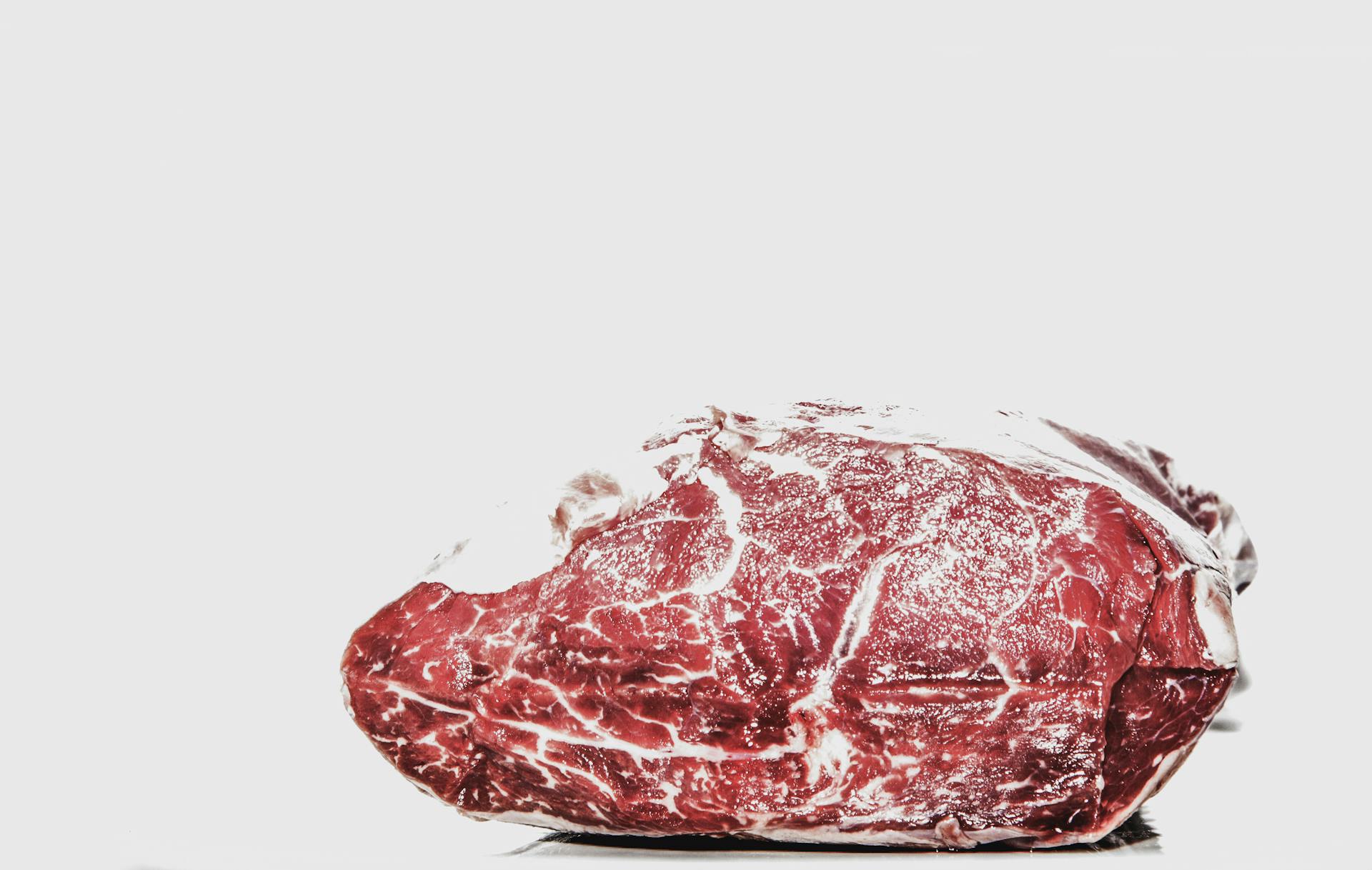
Feeding your dog a raw diet can be a great way to provide them with the nutrients they need, but it's essential to do it correctly.
The ideal feeding schedule for dogs on a raw diet depends on their age, size, and activity level.
Puppies under six months should be fed 2-3% of their body weight in raw food per day, divided into 3-4 meals.
For adult dogs, a good starting point is to feed 1-2% of their body weight in raw food per day, split into 1-2 meals.
What Is the Diet?
The raw-food diet for dogs is made up of completely raw foods, such as fruits, vegetables, and meats.
Raw feeding can be divided into two major techniques: Biologically Appropriate Raw Food (BARF) and the prey-model diet.
The BARF diet is made up of 60 to 80 percent raw, meaty bones and 20 to 40 percent fruits and veggies, meat, eggs, and dairy.
Discover more: Barf Food for Dogs
A prey-model diet strictly mimics what a dog's natural diet would be in the wild, recommending 80 percent muscle meat, 10 percent bone, and 10 percent organ meat.
The BARF diet includes an abundance of supplements, which is an important consideration when deciding how much to feed your dog.
These two diets have different macronutrient ratios, which can affect how much to feed your dog.
Here's an interesting read: Is Chicken Meat Good for Dogs
How to Start
Before starting a raw food diet for your dog, talk to your vet to ensure you're making the right decision.
Dogs' meals should be organic, unprocessed, whole food-based, and raw whenever possible.
Cooked bones are a no-go, as they become brittle and prone to splintering, so stick to raw meaty bones (RMBs) for calcium and phosphorus.
To balance your dog's nutritional needs, you'll need to add ingredients like dog-safe vegetables, legumes, some grains, fruit, and supplements.
You can start by using prepared diets or pre-mixes that you can add your own fresh meat to, which can take the guesswork out of creating a balanced meal.
Locally sourced, small-batch products that are organic and hormone-free are a good choice.
If you're up for the task, work with your vet or an animal nutritionist to ensure you're filling common gaps in canine nutrition, like adding bone meal or eggshells for calcium.
Here's an interesting read: Cooked Meat Bones for Dogs
Methods for Determining Quantities
Determining the right quantity of raw dog food can be a bit tricky, but there are two main methods to consider. You can use a body weight percentage or calories, but finding reliable nutrition data for raw dog food can be challenging.
The body weight percentage option is often suggested for newbies because it's simple and works with any type of raw diet. It's a great way to start, and you can always explore other options once you become more comfortable.
Using calories to calculate raw dog food volume can be tedious and may be difficult for some to execute. You can't count calories if you can't find nutrition data, and some popular items in a raw diet may not have reliable calorie counts.
The body weight percentage option is the method of choice for many raw feeders, and it's often recommended for newbies to start with. It's a straightforward way to determine the right quantity of raw dog food.
Explore further: How to Start Raw Food Diet for Dogs
Calculating and Adjusting
To determine the right amount of raw food for your dog, you need to calculate their ideal weight percentage. This will give you a good starting point, but it's essential to consider your dog's current weight.
Your dog's current weight can significantly impact their nutritional needs, so it's crucial to adjust their feeding amount accordingly. For example, if your dog has lost weight, you may need to increase their food intake to help them gain back a healthy weight.
A good rule of thumb is to adjust their feeding amount by 10-20% to account for weight changes. This will help ensure your dog is getting the nutrients they need while also maintaining a healthy weight.
A fresh viewpoint: Is High Protein Dog Food Good for Dogs
Common Considerations
When switching to a raw food diet, you may need to adjust the amount of food your dog receives on an individual basis. This is because raw food can be more filling than kibble, so you might find that your dog needs less of it.
Some dogs may require more or less food depending on their activity level, age, and overall health. For instance, a high-energy dog may need more calories to maintain their weight, while a senior dog may need less.
You might need to tweak the amount of raw food your dog receives to find the right balance for their unique needs.
Here's an interesting read: What Nutrients Do Dogs Need in Homemade Dog Food
Common Questions
Raw dog food can cause weight loss, even if it's not intended, because it's assimilated differently than starch-based pet foods. This is similar to how a diet of lean meats, fruits, and vegetables can lead to weight loss compared to a diet of fast food like McDonald's.
A healthy dog is always ready to eat, so you can't rely on begging behavior as an indicator of hunger or food volume. It's an inaccurate gauge for food volume.
Use the body condition as your primary guide in determining how much to feed your dog.
Life Stages Considerations
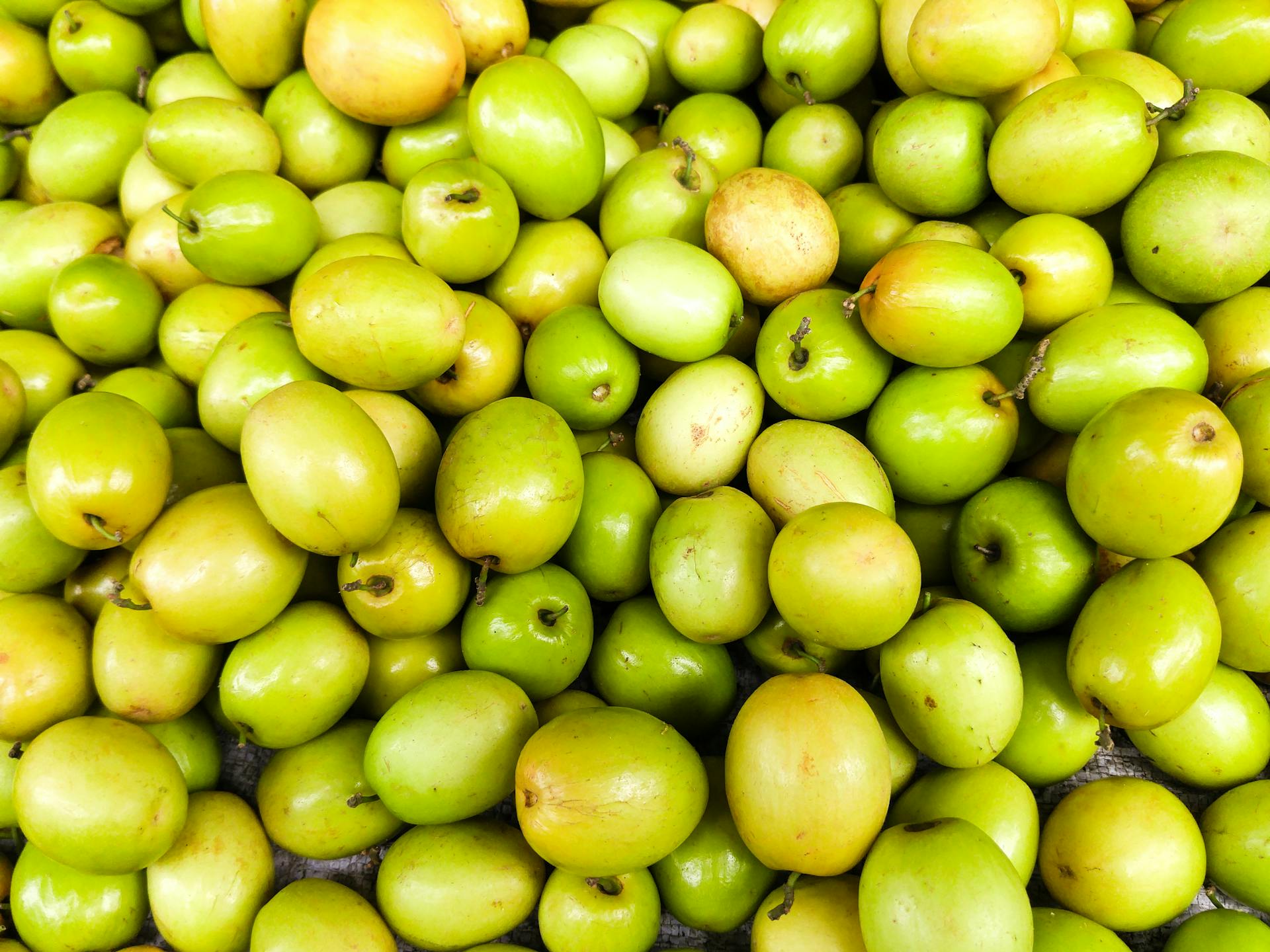
Feeding raw food isn't any more difficult than traditional kibble, especially when it comes to puppies. They'll eat more than adults to fuel their rapidly growing bodies.
You can start puppies on raw immediately, even the day you bring them home from the breeder. Many raw-fed breeders wean their puppies directly onto raw from their mother's milk.
To determine the right quantity for your puppy, you can use two options. Feed 2-3% of their expected adult weight, which is a good starting point.
Diet Risks
Feeding a raw-food diet can be a bit riskier than you might think. All pet foods can contain harmful bacteria, such as salmonella.
Store-bought meat can be a little riskier because it's assumed to be cooked before eating. Meat sold at the grocery store is allowed to have more bacteria than raw diets.
Proper sanitation is crucial when feeding a raw diet. Thoroughly wash your hands and all surfaces, utensils, and dishes after feeding raw food.
Following guidelines for storing raw food is also important. This will help keep you and your family members safe from harmful bacteria.
A fresh viewpoint: How to Cook Deer Meat for Dogs
You May Less
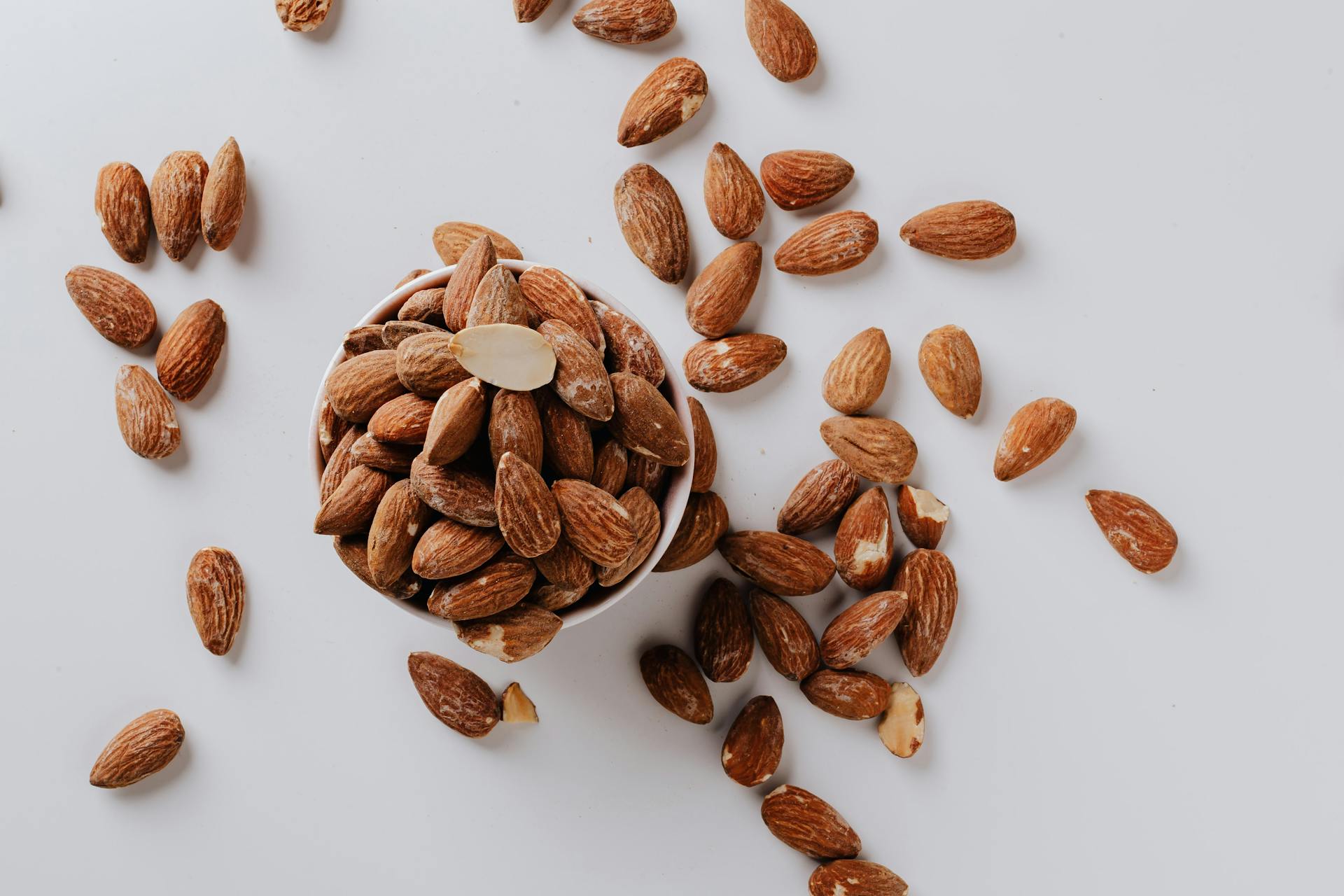
You might need to tweak the amount of raw food your dog receives on an individual basis.
Raw feeding is a lifestyle change, and it requires some trial-and-error to get it right.
You'll never become comfortable with raw feeding unless you put the effort in and learn to do it yourself.
With practice, raw feeding becomes quite simple, but it's essential to learn the ropes and understand what works for your dog.
Feeding and Handling
Raw dog food should be kept frozen until ready to thaw, and then thawed gradually in the refrigerator. Use each 2lb or 5lb frozen chub pack within 72 hours, or repackage and refreeze within 24 hours.
To ensure safe handling, keep raw meat and poultry separate from other foods, and wash working surfaces, utensils, and serving bowls after using. Wash hands after touching raw meat or poultry.
If your pet doesn't eat all the presented food within 30 minutes, discard or refrigerate for up to 24 hours. Keep raw meat and poultry away from children, and treat your dog's food as you would any other raw meat to minimize the risk of contamination.
Serving and Handling Instructions
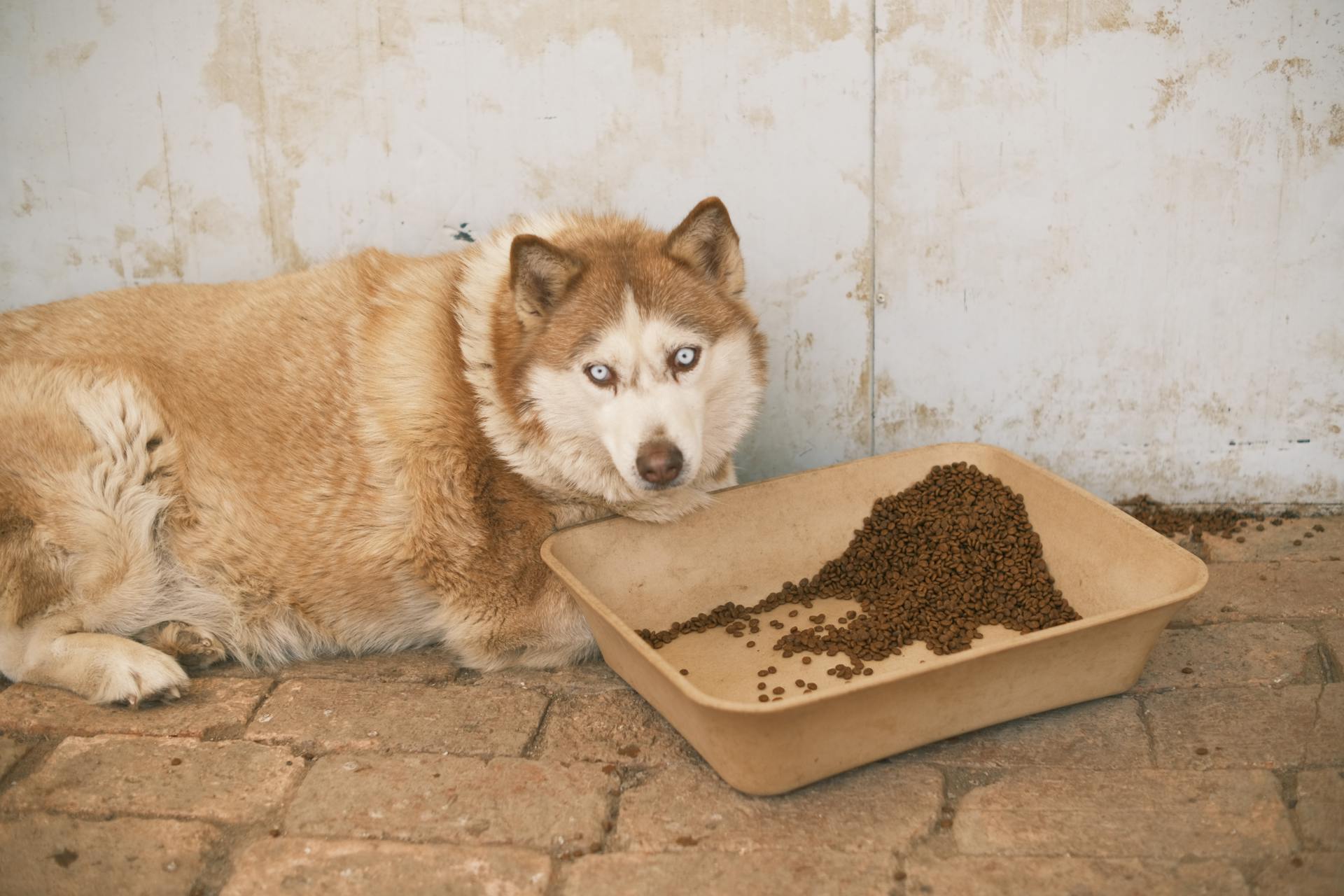
Serving and Handling Instructions are crucial when it comes to feeding your furry friend a raw diet. Always keep frozen raw dog food, like Albright's All-Natural Raw Dog Food, in the freezer until you're ready to thaw it for serving.
Thaw frozen raw dog food gradually in the refrigerator. This will help prevent bacterial growth and keep your pet safe. Use each chub pack within 72 hours, or repackage and refreeze within 24 hours.
Raw dog food requires special handling to prevent contamination. Keep frozen raw meat and poultry separate from other foods in your kitchen. Wash your working surfaces, utensils, and serving bowls after using raw dog food.
Wash your hands thoroughly after touching raw meat or poultry to prevent the risk of bacterial transmission. This is especially important when handling raw dog food. Keep raw meat and poultry away from children and pets who may not understand the risks.
If your pet doesn't eat all the presented food within 30 minutes, discard the leftovers or refrigerate them for up to 24 hours. This will help prevent bacterial growth and keep your pet safe.
See what others are reading: What to Feed Dogs When Out of Dog Food
Bone for Digestion and Dental Health
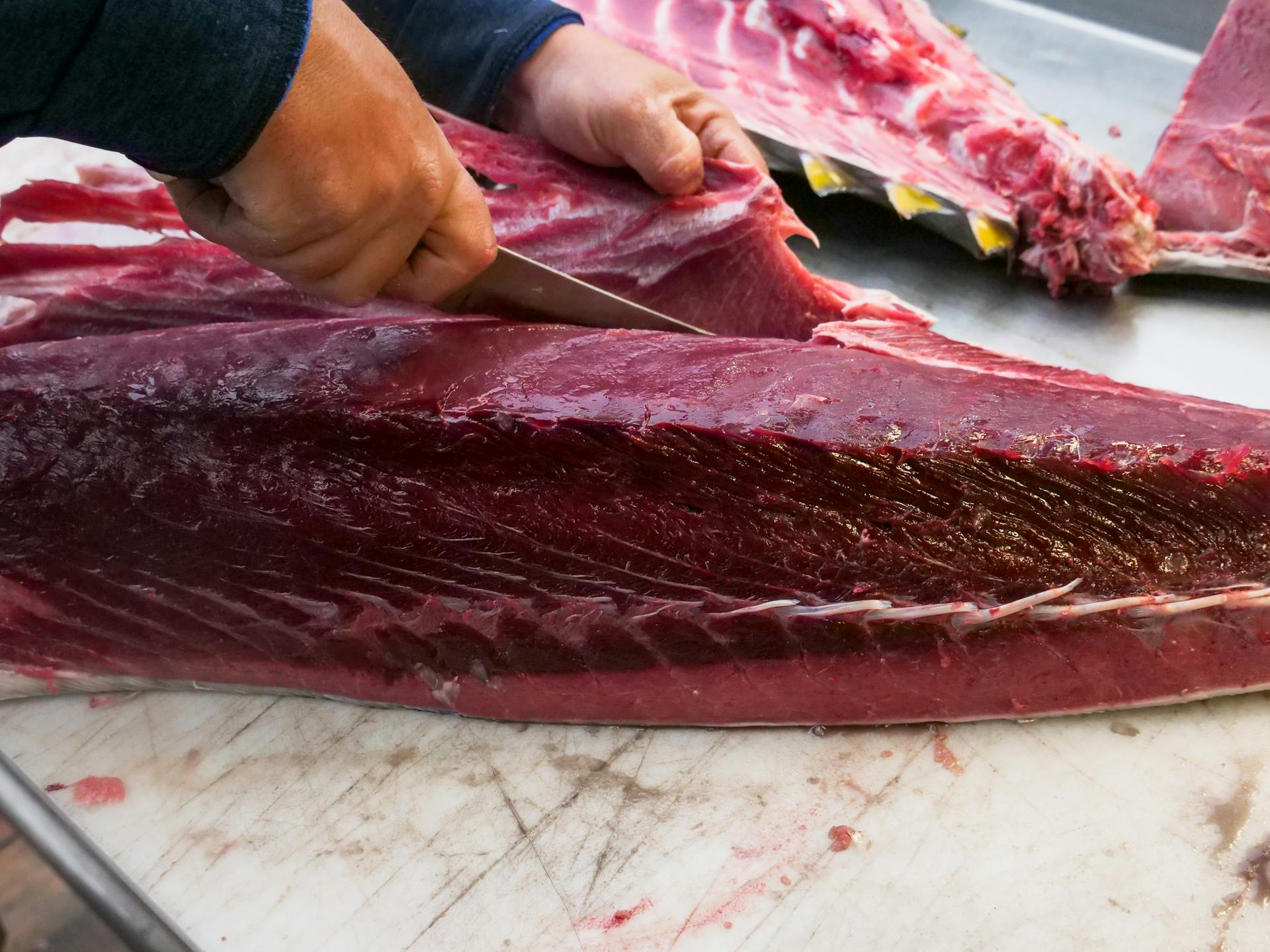
Bone is a crucial element in a dog's diet, providing essential minerals like calcium, magnesium, and phosphorus.
These minerals are found in the 10% ground bone included in ProDog's raw meals, ensuring your dog gets the health benefits they provide.
Allowing your dog to chew on raw, meaty bones, like those found in ProDog's range of bones and chew treats, aids in their dental health as a natural tooth cleaner.
Chewing on bones also helps combat boredom, keeping your dog engaged and stimulated.
Discover more: Do Dogs Chew Their Food
Green Tripe for Gut Health
Green tripe is a nutrient-rich ingredient that can greatly benefit your dog's gut health. It's packed with natural pre and probiotics, digestive enzymes, and promotes an increase in healthy gut bacteria.
Green tripe is the stomach lining of a cow or sheep, and it's a great source of nutrition for dogs. It's essential to choose grass-fed tripe to avoid potential allergy flare-ups from grain-fed cows.
For your interest: Simply Nourish Gut Health Dog Food
Feeding green tripe can be a great way to support your dog's digestive health. If you have an itchy dog or one that suffers from pollen and grass allergies, it's best to introduce it with caution.
A true species-appropriate raw diet should include a variety of animal and botanical ingredients that work together to provide the maximum nutritional benefits.
Transitioning and Guidelines
Transitioning to a raw dog food diet can be a breeze for many dogs, but it's essential to do it gradually to prevent stomachaches and loose stools. Start by mixing 1 part raw food with 3 parts of their current food, and increase the amount of raw food while reducing their previous food over the course of 1 to 2 weeks.
Monitor your dog's temperament and stools to ensure they're transitioning well. If your dog is sensitive, you can check out the story of the sensitive dog of ProDog Raw's Director of Relations, who successfully transitioned to a raw diet in December 2014.
A well-balanced, varied diet is key to your dog's improved health. Avoid ingredients that are hard to digest, such as grains, corn, wheat, and soy, and determine how much raw food your dog needs to achieve the maximum benefits.
Here's a general guideline for transitioning your dog to a raw diet:
Remember, every dog is different, so you may need to adjust this schedule based on your dog's individual needs.
Frequently Asked Questions
What is the 80 10 10 rule for raw dog food?
The 80-10-10 rule for raw dog food is a guideline that recommends a diet consisting of 80% meat, 10% bone, and 10% organ to mimic the natural proportions of prey animals. This ratio helps ensure your dog gets the nutrients they need for optimal health.
How much raw meat should a dog eat per day?
Feed your dog 2-3% of their weight daily, split into two meals, with active dogs needing more and less active dogs needing less. For example, a 50-pound dog needs ½ to ¾ pound of raw dog food per meal.
Featured Images: pexels.com


